I didn’t before, but I now love NASCAR. Over the past couple of years, I’ve had the good fortune to hang around some of the finest engineers, builders, crew chiefs, and mechanics in all of NASCAR. (Plus one middling PR drone.) What I have learned about the science, engineering, and technology required to make a stock car go 185mph for 400+ miles has blown my mind.

So you can imagine my disappointment when one the most respected spokesmen of Science, Mr. Bill Nye, declared NASCAR to be little more than an internal combustion funeral procession of slow, weak, old-timey beaters racing headlong towards that big left turn in the sky.
Advertisement
https://aeon.co/opinions/if-na…
Perhaps he didn’t quite go that far with his contempt for the sport, but he certainly didn’t hold back in declaring NASCAR a serious speed bump that needed to be cleared on our way towards a greener future. (Achem…) But why is Nye going on about this in the first place!?
Sponsored
Nye opens the piece as any good scientist would, by declaring his bona fides. No, I’m not talking about his decades of scientific education, his mechanical engineering degree from Cornell, or even his (honorary) doctorate. I’m talking about the fact that he has family in the South. Virginia to be precise.

He’s also been to Martinsville once. So, with his expertise established, I suppose we can get into his opinion which is, in short that ‘NASCAR is old, dumb, dirty, and useless; if all race cars were electric right now, people would all start driving electric cars.’
Is Mr. Nye right? Could electric motorsport turn the masses on to the humming whir of pure electric motivation? Is there no place for NASCAR in modern motorsports? What will become of the humble gas man!?
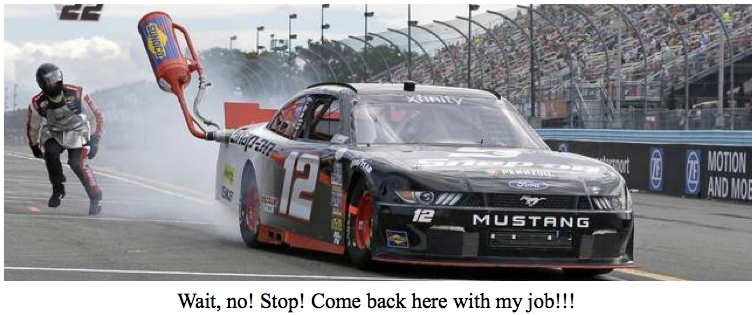

Old Tech (Caution, Graph Ahead!)
For starters, NASCAR has not used carburetors since 2012, but I can let it slide assuming Nye’s intention is to illustrate how relatively out of date the modern NASCAR Sprint Cup car (“cup car”) probably is. And that’s a hard conclusion to argue with. I’m a fan and I actually just had to google whether cup cars even have power steering. (They do!).
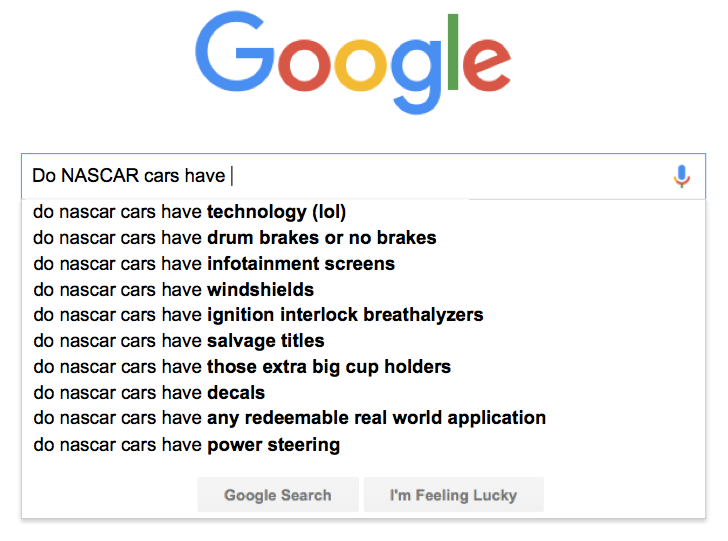
And it would seem that the mere fact that the question must be asked is an insult on its own. But you’d be wrong, because what the sport may be known for best is one of its most defining characteristic: doing the most with the least.
When you get to the numbers in NASCAR, it’s almost unbelievable that they manage to so much with so little. Since television only shows left turns and wrecks, we take it for granted that these metal-skinned cages go 400-500 miles at full throttle, redlining at 10,000RPM and averaging 185mph without blowing themselves to pieces every single weekend. That’s bonkers! (For comparison, the average F1 race is 189 miles.)
But being minimalist doesn’t necessarily mean that “NASCAR tech” is, as Nye opines, woefully outdated and something that should be abandoned. Nye’s declares that NASCAR tech is old, and outdated, the implication being that i lacks the capacity to inform any useful discoveries or modern designs. But I find that conclusion very shortsighted given the cup car pushrod V8’s performance relative to that of an F1 engine, the pinnacle of internal combustion, as explained in this exhaustive comparison.
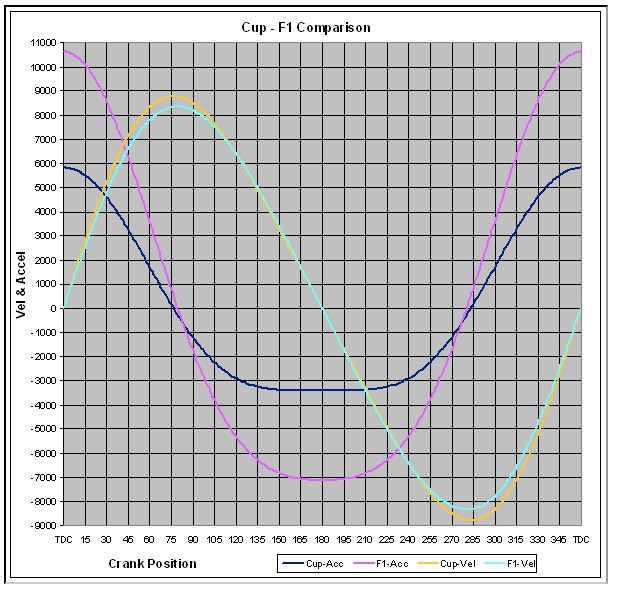

Now THAT’S a graph! Specifically, it’s a graph depicting peak piston velocity and acceleration at red line along all points of rotation of the crankshaft of an F1 engine and a cup engine. Some findings may make you think twice about calling cup engines old. (Come one Bill, stay with me!)
The graph depicts acceleration and velocity of the piston at all points during one 360 degree rotation of the crankshaft where the crankshaft is connected to the piston by the connecting rod. The graph does not account for the amount of time required to rotate said crankshaft. A cup engine at redline rotates at about 10,000 RPM, while an F1 engine rotates at twice that, around 20,000 RPM, which is pretty freaking awesome.
As amazing as all that is, what this actually reveals is that relative to the pinnacle of internal combustion technology, the F1 engine, the modern cup engine is phenomenally good at producing its power and withstanding astonishingly loads. The cup engine’s pistons at 10,000 RPM actually move at a greater velocity than the F1 engine’s pistons do at 20,000 RPM due to the differences in rod/stroke ratio (the ratio of the connecting rod length to the stroke distance of the crankshaft).

That rod/stroke ratio also contributes to the different acceleration curves, with the F1 piston reaching peak negative acceleration at the bottom of the stroke, while the cup car’s peak actually flattens out and remains there for a significant time. Consider too that the F1 piston package weighs in at around 298 grams, while the cup piston pack tips the scales at around 500 grams. Together with the rest of the data, we can see that the force exerted on the cup car’s connecting rod at the top and bottom of the stroke is close to 7,000lbs!!!

That’s more than an Asian Elephant or an F-350 Dually Crew Cab hanging from a single connecting rod 10,000 times every minute for, well, enough minutes to finish a 400 mile race.
And this is merely ONE of those easily overlooked pieces of engineering developed in NASCAR that is decidedly not outdated and has real world implications to the consumer. Considering that all the engine components must work in concert under the same stress, you begin to see what kind of real-world tech is coming out of this sport. A connecting rod manufactured with technology that can withstand the punishment of a full cup race is a connecting rod that is not going to fail on your daily driver, and that’s one less car in a landfill.
For Bill Nye, though, engine longevity only means that he’s gonna have to keep his hackles on end for that much longer, because…
Fuel Consumption and Power
This appears to be Nye’s number one beef: the consumption of any amount of fuel.

This one is hard to shy away from because, as well all know, fuel makes power. And the more power you have the more horses you have and the more torques you have, and the faster you go! And so you go get even more fuel for even more power and go even faster! It’s an endless cycle! But seriously, there is no racing without it.
Unless, of course you buy electric. That’s because, as we all know quite well, electric power is transcendent. It’s monumental. The torques are forever and boundless and it wins in every drag race!
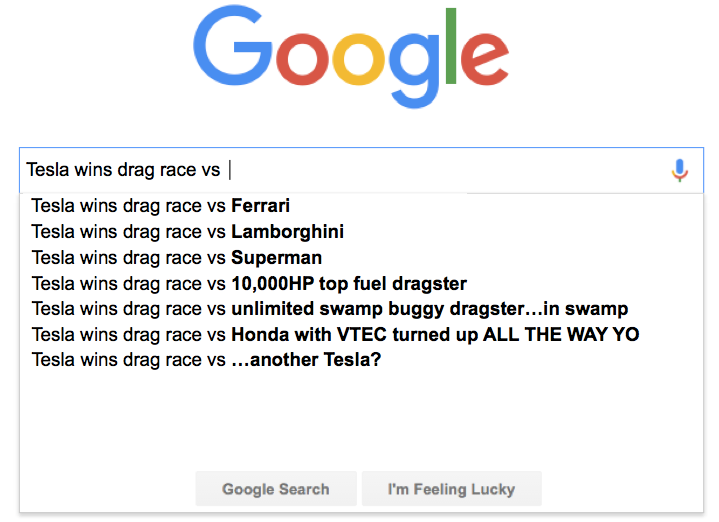
These are all 100% real.
They shouldn’t even measure electric power in horses at all, they should measure it in something bigger than horses – they should measure it in Paraceratheriums, which google says is bigger than a horse. It’s also extinct, which would be sort of poetic for measuring electric horsepower.

Silliness aside, though, how much power are we really talking about? Does a Tesla off the showroom (?) floor even compare with a fully race prepped cup car? The numbers might surprise you.
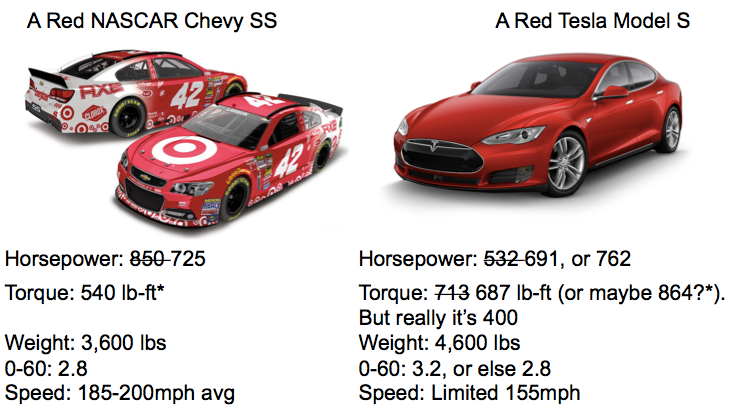
Or rather the numbers might evade you. It turns out they’re harder to come by than you’d think. NASCAR has recently instituted a new rules package that will see the overall horsepower of the cup cars lowered via fancy restrictor plates from 850hp to 725hp. What is not well known as of yet is how this will impact torque. Officially, it remains to be seen.
To the Tesla. Nye quotes the Tesla’s HP figure as 532, but Wikipedia puts the P85D at 691, and 762 when Ludicrous Mode is activated. Tesla torque figures are certainly out there, but they’re all over the place. While Nye quotes 713, Wikipedia puts the P85D at max torque of 687 lb-ft. Road & Track actually dynoed a P85D in Ludicrous mode and returned an astonishing 864 lb-ft. However they also point out that the torque curve peaks sharply, and then settles out down around about 400 lb-ft. So, again, it’s tough to really say.
http://www.roadandtrack.com/new-cars/video…
Going the Distance
But since Cup races aren’t drag races, we’re really concerned about longevity and what it takes to complete a 400 mile race.
As Nye points out, a cup car gets about 4 mpg and carries at most 24 gallons of fuel on board. At 4 miles per gallon, 24 gallons will carry the car roughly 96 miles. The car could conceivably race all 400 miles on 4 fuel stops and a total fuel usage of less than 100 gallons. Unless you’re Juan Pablo Montoya, then your car gets 4 gallons per second and can’t make it around the track at all without trying (unsuccessfully) to refuel mid-lap.
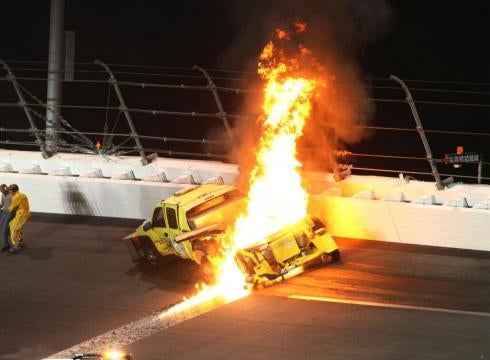
For the Tesla, the story isn’t quite so clear. It’s difficult to predict what the power usage might be at sustained full throttle, but it’s certainly not going to be one mile of range per mile covered. The closest I’ve found to go by in the real world is this video of a P85 cruising at 125mph for just short of 11 minutes.
- The range at the beginning of the run at 217 miles (249km), around 40 miles short of the reported 256 mile max.
- At the end of the run, range is down to 151 miles.
- That’s a “consumption” of 66 miles over 11 minutes at 125mph.
- At that speed and time the car covered roughly 22 miles, so “3 range miles per mile”.
- If range is depleted linearly, like fuel, then the Tesla, at 125mph, would exhaust it’s 256 mile max range in around 85.5 miles.
Assuming Nye’s presumption that fully charged batteries would be on hand to swap into the depleted cars, that would mean 5 full sized Tesla P85 batteries at 1,200 lbs. a piece for a total of 6,000 lbs to complete a race. For comparison, that 5,275 lbs. more “fuel” than a cup car requires over the same distance, to say nothing of the potential longevity and environmental impact of that many batteries per car.
http://www.slate.com/articles/techn…
And then there are the speeds. Assuming a cup car averaging 185 mph, while a Tesla is limited to a top speed of 155.
- With no stops the cup car at 185mph would cover 400 miles in 2:12.
- The P85 at 155mph with no stops would cover 400 miles in 2:34, 22 minutes behind the cup car.
- Assume 2.5 miles per lap, the cup car covers 3 miles per minute and one lap every 50 seconds.
- At 22 minutes behind, the Tesla would finish at best 18 laps down from the cup car, all things being equal.
Ugh…This is a phenomenally dumb comparison, but so is comparing a cup car to a Tesla, or a Tesla to a fictional spy’s one-off supercar. I’m sure with a tweak or two, someone could get a Tesla up to 200, though I doubt the battery would be around to see the end of the run. Like I said, it’s just a really dumb comparison.

Fairness where fairness is due: the comparison between a cup car and any Tesla are completely without merit and useless for achieving any kind of comparison. One is a tuned hypermachine burning fuel, while the other is a consumer-grade sedan. This is, of course, where I should trot out Formula E and compare those ranges (which is typically given as 30 minutes, and not miles or kilometers), but I’m not going to because that comparison is not just dumb, it’s unwarranted. Formula E is years away from being a serious top tier series and they don’t even “refuel” (swap batteries) at pit stops, they swap the whole damn car! (That infuriates me for some reason.)
That said, I hope that one day Formula E can work out the kinks and that the engineers can figure out how to translate it to a stock car. I hope I will one day see an enormous brick of an electric stock car whirring around a track at upwards of 200 mph for hours and knowing that the engineers, designers, and builders have created a machine that can do such a thing. I hope that until then, NASCAR continues to nurture the spirit of ingenuity that the next generation of drivers and engineers and designers will need to create an electric car out of duct tape and some old potatoes, or whatever “old tech” NASCAR will adopt in the forthcoming electric age.

Electric is the future, and Nye’s sentiments are clear and on point even if his aim is about as good as a four-year old at the big kids urinal. (You’re just getting it all over your shoes, son.) The ICE is on its last laps, or at least it should be. Nonetheless, a slower, quieter, heavier, untested platform for electric stock car racing, while certainly intriguing to think about, would most certainly not sway fans today for whom there is no replacement for displacement.
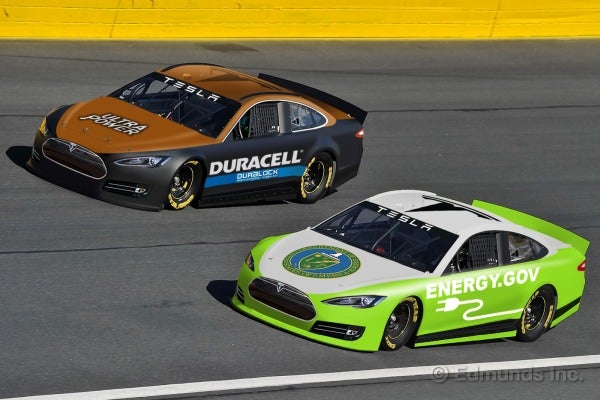
Nope.
In the end, though, it all comes down to the fans. And who the hell wants to watch Dale, Jr. put his car on Autopilot and nap his way to another checkered flag at Talladega!? Ok, that would actually be kind of awesome.













